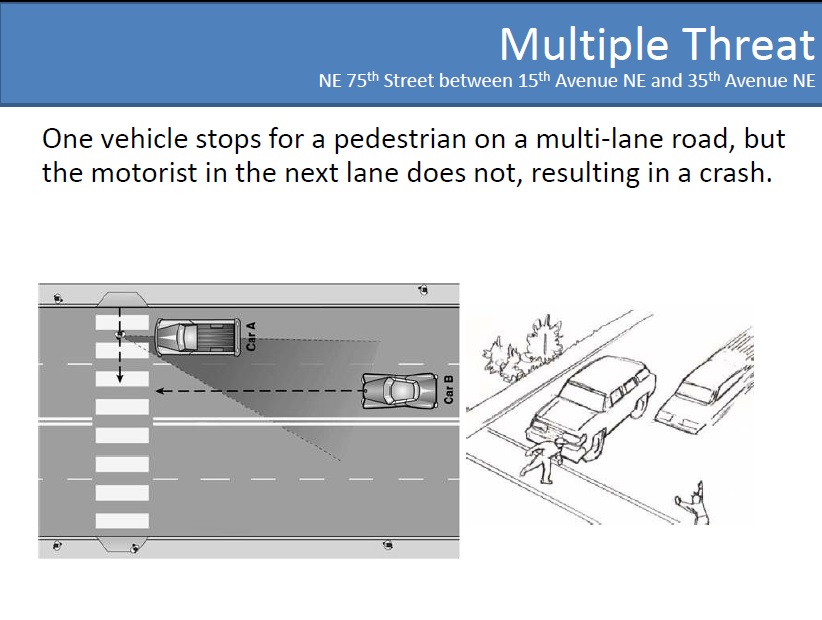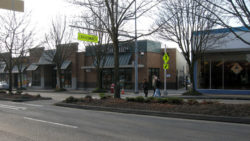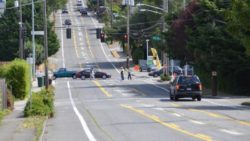The need to make NE 65th Street safer is evident. Over the past three years, at least 70 people have been injured enough to be sent to the hospital. One person died. Just within the last few weeks, the Seattle Police Department has reported collisions on NE 65th Street. Pedestrian safety problems on NE 65th Street were the most commonly expressed concerns in a recent RBCA survey. In June, more than 60 neighbors participated in a Fix 65th Street walk to highlight concerns and call on the City to make the road safer for all. And this is all before the Roosevelt light rail station opens on NE 65th Street to which many of our neighbors will walk and bike.
Increasing awareness of the law and educating neighbors about road safety is part of RBCA’s recently-adopted mobility safety action plan. Openly discussing the community norm that stopping for pedestrians is just what Ravenna-Bryant neighbors do, can be an important step to increasing safety. However, to most effectively create change, other activities need to happen in conjunction with awareness campaigns.

When RBCA was assessing mobility safety problems in our neighborhood, we also looked at road designs that have proven to increase safety. While we found a lot of information from government agencies and transportation-related organizations, some of the most readily accessible information came from the AARP Livable Communities initiative. The goal of the Livable Communities campaign is to help communities become safer, healthier, more walkable, and more livable for all people.
One of their recommendations for creating a more livable community is to calm traffic. In a recent RBCA survey, motor vehicle speeds on arterial roads was a top mobility-related complaint. Decreasing the speed at which motorists travel contributes to increased safety for pedestrians, bikers, and motorists. “Traffic calming is a system of design and management strategies that include narrow roads, modern roundabouts, chicanes (intentionally added turns in the road), median islands, speed bumps, diverters, speed tables and other engineering tools or interventions,” according to a Livable Communities fact sheet. “Another benefit of traffic calming is that it can give a street a transformative sense of place, thus boosting social interactions, housing and retail businesses.”
Some of the traffic calming designs, like chicanes and diverters, may not be appropriate for busy arterial roads like NE 65th Street in the Ravenna-Bryant neighborhood. However, several of the design elements recommended by the AARP’s initiative could be.

Median islands are raised areas in the center of a street that provide refuge for pedestrians. They provide a safe place to stop when crossing a busy street and calm traffic. If wide enough, islands can include trees.
Speed tables and speed bumps raise a section of the road, reducing vehicle speeds. The speed table where the Burke-Gilman Trail crosses 30th Avenue NE is an example of how they can provide a mid-street crossing in conjunction with curb bulbs.
Recent traffic calming changes focusing on narrowing roads without median islands in Seattle have proven successful in increasing safety for all who use them. Closest to home is the redesign of NE 75th Street. Traffic calming elements that were implemented include marked travel lanes, a center turn lane, and painted bike lanes. Single lanes of motor vehicle traffic in each direction with a center turn lane calm traffic while also allowing motorists to not be impeded by people turning left.

After the NE 75th Street project was complete:
- Collisions reduced by 45%;
- Speeds reduced by 9%;
- Traffic volumes increased 3%;
- Travel times did not change.
Similar results have been seen on Stone Way N between N 34th and N 50th Streets and NE 125th Street.
While curb bulbs are not specifically listed in the Livable Communities information about safe streets, they extend the sidewalk to shorten the street crossing distance for pedestrians. The corner of 40th Avenue NE and NE 50th Street includes curb bulbs.
We know what works for developing safe environments for pedestrians, bikers, and motorists. As neighbors, we can come together and combine awareness and education activities with changes to street design and create a safe, livable community.
